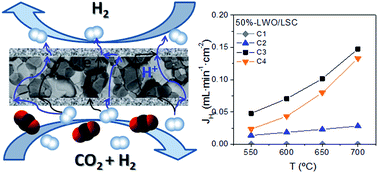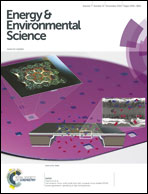Outstanding hydrogen permeation through CO2-stable dual-phase ceramic membranes†
Abstract
Mixed electronic- and protonic-conducting composites made up of physical mixtures of La5.5WO11.25−δ–La0.87Sr0.13CrO3−δ (LWO–LSC) have been evaluated as H2 separation membranes for operation at temperatures greater than 550 °C. The mixture of these two ion-conducting phases led to non-linear synergetic effects; i.e. unexpected enhancement of the total conductivity and well-balanced ambipolar conductivity, resulting in appealing H2 permeation fluxes through robust ceramic membranes. The preparation, primary characterization, H2 permeation and stability studies of various composites is presented. Mixing LWO and LSC phases makes it possible (1) to improve the LSC sintering behavior and to achieve very high membrane densities and (2) to obtain compounds with high total conductivity, higher than that shown for LWO and LSC, separately. The highest permeation rate is achieved for the 50 vol%-LWO–LSC membrane, though other composite compositions showed higher total conductivity. Moreover, the influence on the H2 permeation of the composite composition, the humidification of gas streams, temperature and the use of various catalytic coatings on the membrane surface is evaluated. The nature of the transport mechanism is investigated by the permeation studies using deuterium tracers. The H2 permeation rates reported in this investigation for a 370 μm thick 50 vol%-LWO–LSC membrane, e.g. 0.15 mL min−1 cm−2 at 700 °C, are the highest reported values, up to date, for any bulk mixed protonic-electronic membranes. The H2 permeation magnitude achieved at moderate temperatures along with the proven stability in CO2-rich atmospheres are firm steps towards the future application of this type of membrane for industrial processes.


 Please wait while we load your content...
Please wait while we load your content...